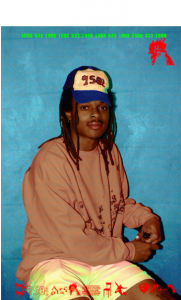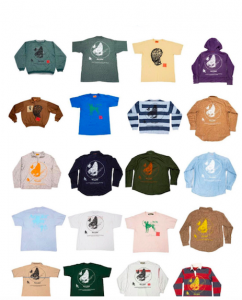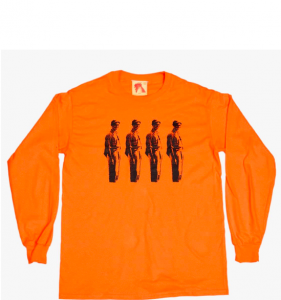A Local Balancing Act: Business, Art, and Ethics
Elliott Obermaier
Chazz Mack first entered the fashion industry with the goal of expression. Like most young designers, he valued art over everything and wanted to showcase his creativity, talent, and fashion acumen. A former Indiana University student, Mack spent the last three years of his college experience constructing a clothing brand, Arcola. The company remains a local brand but quickly expanded within the Bloomington and Indianapolis communities over the last three years. Based on popular trends and Mack’s own creative vision, Arcola primarily produces branded t-shirts and hoodies with an emphasis on “items with ethos” (Mack, Obermaier, 2021). Most importantly, Mack is an independent designer who is quite conscious of the fashion industry’s faults.

These very faults pushed him to move past simply, “being an artist.” They forced him to become an ethical business owner. Especially for a small business hidden in an industry as large and systemically connected as fashion, this proved incredibly difficult to do. As Mack quickly found out, entering any industry elicits a steep learning curve, and small businesses have a minuscule margin for error based on their operating costs and reliance on larger corporations. Yet, the most fascinating development for Mack and Arcola came when Mack decided to make riskier, more expensive business decisions for the sake of fashion ethics. So what exactly about the fashion industry is so terrible that forced him to rethink how he runs his brand?
The Unethical Nature of Fashion:
Picture your favorite t-shirt. Where did you get it? My favorite is a grey and orange, “2014 San Francisco Giants World Series Champions” crewneck made by Majestic. The memories of watching that World Series victory and the moments are seemingly woven into that materialistic, cotton t-shirt certainly elevate its status among my other t-shirts, as is the case with everyone’s favorite. That said, the Kansas City Royals also competed in the 2014 World Series. The very same Majestic “Champions” t-shirt that I wear today exists, but adorned in a Kansas City blue and gold color scheme. Unlike my t-shirt, the majority of these shirts sit idly at the bottom of a landfill. This t-shirt story is commonplace within the fashion industry. Every sports team who lost a championship already had t-shirts made and ready for excited fans to buy. Every skirt trend that flamed out due to fast fashion’s high rate of design change found its way to the landfill. In fact, the Environmental Protection Agency reported in 2018 that of the 17,030 tons of textiles produced, 11,300 tons ended up in landfillsthe Environmental Protection Agency reported in 2018 that of the 17,030 tons of textiles produced, 11,300 tons ended up in landfills (Environmental Protection Agency, 2018). Even more horrifying, most of these materials have to end up in a landfill, as approximately 60% of textiles are not even recyclable (Portela, 2021). In short, your favorite t-shirt, my favorite t-shirt, and so many other material items directly contribute to the ever-worsening environmental crisis.
To Mack and Arcola, the aforementioned environmental issues caused by overproduction and pollution from production processes forced him to reassess how he viewed the industry and his company’s role within it. Importantly, these issues did not deter him from the fashion industry. Instead, the awful amounts of waste pushed him to learn more about the clothes he designs and their production cycle. In our interview, Mack illuminated that finding fashion industry information proved immensely challenging for a small business and newcomer in the fashion world. Understanding the t-shirt supply chain dynamic and price flow when purchasing materials was an incredibly difficult.

Arcola’s product development consists of printing Mack’s design onto blank t-shirts (colloquially known as blanks). Companies such as Independent Trading Co, Gildan, and Jerzees all are wholesale t-shirt providers that provide blanks for fashion designers, businesses, and a variety of organizations to print their design on. These distributors offer a wide array of simple products, but public information on their design, construction, and supply chain movements hardly exists. A conscious business owner, Mack knew that Arcola should source its products from ethical companies who treated both their workers and the environment well. Therefore, he extensively researched t-shirt manufacturing, t-shirt supply chains, distribution, and worker’s conditions to further understand his products.
The Traditional T-Shirt Supply Chain
The t-shirt supply chain begins in China, India, and the U.S., who were the world’s top cotton producers in 2021. The three countries generated 6.4 million, 6.1 million, and 3.1 million metric tons of cotton respectively. To combat the incredibly cheap labor costs of China and India, the U.S. built an entire engineering industry dedicated to efficiently farming cotton (specifically on northwest Texas). Once farmed, the companies ship the raw goods to textile factories (often in China) where they are woven from cotton into the cloth fibers, yarn, and other textiles materials (Pietra, 2014). Still not finished traveling, the newly transformed materials make their way to sweatshops all over the world where cheap, expendable, and terribly treated laborers stitch together the very t-shirts you and I consider our favorites. From here, the newly minted clothes find their way into stores and retail centers for consumers.

After he detailed this complex, polluting, and wasteful nature of the t-shirt supply chain, Mack connected this process to Arcola’s products. He described how having more access to this type of information did not necessarily make business decisions easier. Unlike massive corporations who merely choose the cheapest product, Arcola emphasizes ethics when making sourcing decisions. Appropriate prices, country of origin, or a supplying company’s environmental policies all determine how Mack chooses his blanks supplier. But, the shrouded nature of t-shirt supply-chain management does not offer a clear choice. According to a 2017 University of Manchester environmental analysis of twenty fashion companies, supply chain leadership from these companies rarely incorporates sustainable policies unless they meet a certain profit margin through the policies (Shen, Li, Dong, 2017). Companies invested in sustainable or local supply chains will rarely publish their methods unless they have a green initiative which they want public consumers like Mack to know about. In an industry with more than 30 million tons of product distributed globally, manufacturers have more power within the supply chain than retailers and consumers In an industry with more than 30 million tons of product distributed globally, manufacturers have more power within the supply chain than retailers and consumers (Shi, Qian, Dong, 2017). Therefore, independent businesses who rely on manufacturers (like Arcola) have limited choice in where to buy product from.
Regarding his ability to make ethical business decisions, Mack immediately addressed t-shirt supply chain issues. He consistently tries to purchase his blanks from US-based manufacturer, Bayside Blanks. Citing the desire to buy locally, reduce carbon emissions, and humane worker treatment, this is his preferred product for Arcola. That said, the sourcing solution is not nearly that simple. Due to their local nature and higher quality, other ethical producers or consumers like Mack also prefer Bayside Blanks. In turn, their products are often out of stock and their prices are marginally higher. Here, Mack reflected upon the problem that arises in seemingly every situation for someone trying to enter the fashion industry. “I’m an artist and a businessman. These two don’t always have the same ends” Chazz Mack “I’m an artist and a businessman. These two don’t always have the same ends” (Mack, Obermaier, 2021). Mack admitted that when Bayside Blanks’ supply is out and he must deliver products, he will purchase blanks from other suppliers. SS Activewear is one of the leading manufacturers for quickly delivered blanks. While the company is still overseas, Mack found them to be more environmentally conscious and focused on ethical worker’s rights than most. Importantly noted, Mack did state that information about supply chain models and various company’s policies has become more accessible throughout the three years of Arcola.
Understanding t-shirt supply chain models is merely one of the ethical challenges Mack first faced when growing Arcola and learning how to structure his business model. During our interview, he very consciously acknowledged the environmental concerns with screen-printing and producing designs. One of the most jarring moments during Arcola production came when Mack saw the amount of water used for dying and printing at the local clothing company In Case of Emergency Press (Mack, Obermaier 2021). Dying clothes involves submerging blank shirts in a barrel of dyed water and letting it absorb the color. According to a 2019 environmental study conducted by the World Resources Institute, this process uses 2,700 liters of water per shirt (Reinhart, Drew, 2019). Needless to say, this is a jarringly wasteful process and Mack recognized this immediately.
The dichotomy between large supply chain manufacturers and small businesses is incredibly unequal. Access to information and the sheer reliance of small businesses on the large corporations gives independent designers, brands, and small companies almost no power in this relationship. That said, my discussion with Mack and Arcola’s design process illuminates why small businesses are so incredibly important to creating an ethical space for clothing. Business owners like Mack understand their scope, thus they can make decisions that consciously address the size of their market, quality of goods, and emphasize local t-shirt supply chains. Rather than focus on mass production to meet demand, companies like Arcola utilize their size to create more sustainable production processes. Simply put, they have more autonomy by not needing to meet greater consumer demand.
Arcola’s Production Process
Local and upcoming fashion designers must choose how they participate in the sectors of sourcing, fast fashion, and distribution in order to be both successful and impactful. Throughout the three years of Arcola’s existence, Mack learned how he could conduct business efficiently and ethically while growing his brand and ensuring he can financially sustain the company.
Once the blanks arrive in Bloomington, everything else within the Arcola process is local. First, the t-shirts’ designs are screen-printed at In Case of Emergency Press, a Bloomington, Indiana company. Next, Mack ships or delivers all of the merchandise himself (Mack, Obermaier, 2021). He hand-packages the products and takes them to the local USPS. If customer orders are in Bloomington, he’ll personally ensure the product reaches customers. Moreover, he pulls all his promotional content from fellow Bloomington artists. Arcola’s advertising material incorporates local models and local photographers do all of the shooting.
These are the components of local business Mack enjoys most. Beyond the actual design process, he loves integrating his brand with the Bloomington community and ensuring that the local scope of Arcola supports fellow artists. As he stated in our interview, “I design Arcola to be clothes with ethos” (Mack, Obermaier, 2021). Moreover, he knows the importance of incorporating sustainable methods to offset the effects of wasteful sourcing. Some of Mack’s most interesting designs are recycled clothes, thrifted from Goodwill or Salvation Army and then screen-printed with the Arcola graphics. He refutes the idea of Arcola becoming a massive fashion brand that cannot be sustainable.
Undoubtedly, the fashion industry is remarkably flawed, and entering such a flawed environment requires some means of participation. Here lies Mack’s greatest challenge. To what extent must an entrepreneurial brand like Arcola become a part of the fashion industry’s faults in order to survive as both an art and a business?
Considering that the fashion industry needs conscious designers and businesses to become increasingly sustainable and ethical, Arcola is the type of brand that could promote local fashionHowever, as Mack expressed, becoming that type of brand does not come without sacrifices and difficulty. Entering the industry proved challenging as information was not readily available. However, as Mack expressed, becoming that type of brand does not come without sacrifices and difficulty. Entering the industry proved challenging as information was not readily available. In order to even manufacture a tangible product on a semi-reasonable budget, Mack needed the large-scale blank suppliers. To find reliable information about sourcing and how local designers could find ethical but reasonable prices, Mack started an apprenticeship at In Case of Emergency Press. Very intentionally, he pointed out during our interview that Arcola grew much more efficiently when he started his apprenticeship at In Case of Emergency Press due to simply having wider access to the fashion industry. Naturally, his experience showcases the incredible difficulty and near-impossible task of starting a clothing brand and operating sustainably at every stage of production.
Mack is one of many to experience being absorbed into the fashion industry’s global cycle. To a degree, participating in unsustainable fashion and production is unavoidable. That said, Arcola has reached a large degree of success in relation to the majority of startup brands and designer ideas. And yes, Mack had to participate in the wider fashion industry to get there. However, his success combined with conscious choices makes Arcola an exemplary brand. The more local designers push to scale their products to a sustainable equilibrium, the more massive textile corporations will meet local needs. At the end of the day, Mack did acknowledge to find success in his passion, he must be both artistically, ethically, and economically aware. Indeed, that requires some degree of participation in global supply chains and poor corporate practice. It’s unachievable to balance all three of art, ethics, and business awareness perfectly. However, the fashion industry can and should recognize the important focus on those three pillars. Fashion newcomers, like Chazz Mack, should center their business on these three aspects in order to improve the industry.
References
Cline, Elizabeth L. (2012). Overdressed: The Shockingly High Cost of Cheap Fashion. Penguin Group.
Environmental Protection Agency. (2021). Textiles: Material Specific Data. United States Environmental Protection Agency. epa.gov. https://www.epa.gov/facts- and-figures-about-materials-waste-and-recycling/textiles-material-specific-data
In Case of Emergency Press. (2009 – 2021). About – Contact information & the mission behind out operation. InCaseofEmergencyPress.com. https://www.incaseofemergencypress.com/about/
Obermaier, Elliott. Mack, Chazz. (2021, November 3rd). [In -Person Interview with Chazz Mack & Arcola].
Portela, Valentina. (2021). The Fashion Industry Waste Is Drastically Contributing to Climate Change. California Public Interest Research Group.
Reichart, Elizabeth. Drew, Deborah. (2019, January 10th). By the Numbers: The Economic, Social, and Environmental Impacts of “Fast Fashion.” World Resources Institute.
SS Activewear. (2021). SS Active Wear – About. SSActivewear.com https://www.ssactivewear.com/about/
Rivoli, Pietra. (2014). The Travels of a T-Shirt in the Global Economy: An Economist Examines the Markets, Power, and Politics of World Trade. John Wiley & Sons Incorporated.
Shahbandeh, M. (2021). Leading cotton producing countries worldwide in 2020/2021 (in 1,000 metric tons). Statista. https://www.statista.com/statistics/263055/cotton-production-worldwide-by-top-countries/
Shen, B. Li, Q. Dong, C. Perry, P. (2017). Sustainability Issues in Textile and Apparel Supply Chains. Sustainability, MDPI.
Shi, X. Qian, Y. Dong, C. (2017) Economic and Environmental Performance of Fashion Supply Chain: The Joint Effect of Power Structure and Sustainable Investment. Sustainability, MDPI.
